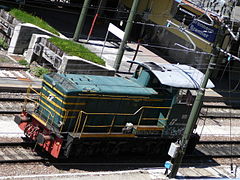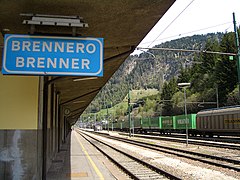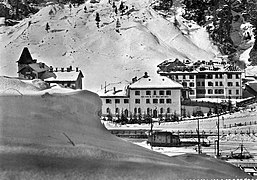
Italy has a well developed transport infrastructure. The Italian rail network is extensive, especially in the north, and it includes a high-speed rail network that joins the major cities of Italy from Naples through northern cities such as Milan and Turin. The Florence–Rome high-speed railway was the first high-speed line opened in Europe when more than half of it opened in 1977. Italy has 2,507 people and 12.46 km2 per kilometer of rail track, giving Italy the world's 13th largest rail network. The Italian rail network is operated by state-owned Ferrovie dello Stato, while the rail tracks and infrastructure are managed by Rete Ferroviaria Italiana.
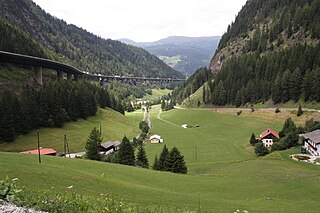
The Brenner Pass is a mountain pass through the Alps which forms the border between Italy and Austria. It is one of the principal passes of the Eastern Alpine range and has the lowest altitude among Alpine passes of the area.

Milano Centrale is the main railway station of the city of Milan, Italy, and is the largest railway station in Europe by volume. The station is a terminus and located at the northern end of central Milan. It was officially inaugurated in 1931 to replace the old central station, which was a transit station but with a limited number of tracks and space, so could not handle the increased traffic caused by the opening of the Simplon Tunnel in 1906.
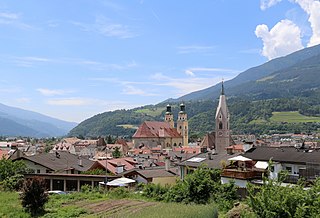
Brixen is a town in South Tyrol, northern Italy, located about 40 kilometres (25 mi) north of Bolzano.
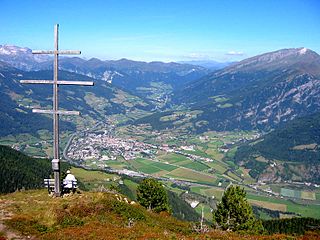
The Wipp Valley is an Alpine valley in Tyrol, Austria and in South Tyrol, Italy, running between Innsbruck and Franzensfeste. The Brenner Pass at the Austro-Italian border divides it into the northern, Austrian Lower Wipp Valley and the southern, Italian Upper Wipp Valley. The Lower Wipp Valley extends along the Sill River southward from Innsbruck, where the Sill meets the larger Inn River, up to the Brenner Pass. South of the border, the Upper Wipp Valley stretches along the Eisack River by way of Sterzing to Franzensfeste. It forms the Wipptal District of the province of South Tyrol.

Bologna Centrale is the main railway station in Bologna, Italy. The station is situated at the northern edge of the city centre. It is located at the southern end of the Milan-Bologna high-speed line, which opened on 13 December 2008, and the northern end of three lines between Bologna and Florence: the original Bologna-Florence line through Porretta Terme and Pistoia; the Bologna–Florence Direttissima via Prato, which opened on 22 April 1934 and the Bologna-Florence high-speed line, which opened to traffic on 13 December 2009.

The Brenner Base Tunnel is a 55-kilometre-long (34 mi) railway tunnel under construction through the base of the Eastern Alps beneath the Brenner Pass. Upon completion, it will be the second or third longest railway tunnel in the world, after the Gotthard Base Tunnel in Switzerland and the Mont d'Ambin Base Tunnel between France and Italy. It will run from near Innsbruck, in Austria, to Franzensfeste, in Italy, replacing part of the current Brenner railway. The line is part of Line 1, the Berlin to Palermo route, of Trans-European Transport Networks (TEN-T).

The Brenner Autobahn refers to a major European truck route that connects Innsbruck in Austria to Verona in northern Italy.

Innsbruck Hauptbahnhof is the main railway station in Innsbruck, the capital city of the Austrian federal state of Tyrol. Opened in 1853, the station is a major hub for western and central Austria. In 2019, it was the 8th-busiest station in the country, and the 2nd-busiest outside of Vienna after only Linz Hauptbahnhof, with 315 train movements and 38,500 passengers daily.
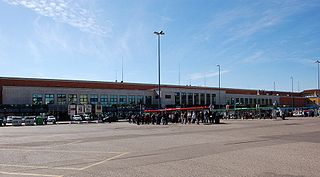
Verona Porta Nuova is the main railway station of Verona, Italy. It is one of the two stations serving central Verona; the other station, Verona Porta Vescovo, is located at the east of the city.

The Brenner Railway is a major line connecting the Austrian and Italian railways from Innsbruck to Verona, climbing up the Wipptal, passing over the Brenner Pass, descending down the Eisacktal to Bolzano/Bozen, then further down the Adige Valley to Rovereto/Rofreit, and along the section of the Adige Valley, called in Italian the “Vallagarina”, to Verona. This railway line is part of the Line 1 of Trans-European Transport Networks (TEN-T). It is considered a "fundamental" line by the state railways Ferrovie dello Stato (FS).

The Berlin–Palermo railway axis is project No. 1 of the Trans-European high-speed rail network (TEN-R), which involves the creation of a 2,200-kilometre-long (1,400 mi) high-speed rail line between Berlin and Palermo. It is designated as one of the main transport links connecting Central and Southern Europe, tracking through Germany, Austria and Italy.

Bolzano/Bozen railway station is the main station of Bolzano/Bozen, capital of the autonomous province of Alto Adige/Südtirol, in northeastern Italy.

Trento railway station is the main station of Trento, capital of the autonomous province of Trentino, in northeastern Italy.

Rovereto railway station serves the Comune of Rovereto in the autonomous province of Trentino, northeastern Italy.

Kufstein railway station serves the city of Kufstein, in the Kufstein district of the Austrian federal state of Tyrol. Opened in 1876, it is an Austrian-German border station, close to the border between Tyrol and Bavaria.

The Drava Valley Railway is an east–west railway running along the Drava. It runs from Maribor to Innichen, where it merges into the Puster Valley Railway to Franzensfeste (Fortezza). It starts in northern Slovenia, crosses Carinthia and East Tyrol and ends in South Tyrol. The Klagenfurt–Bleiburg section has been rebuilt as part of the Koralm Railway, which follows the Jaun Valley Railway (Jauntalbahn) from Bleiburg. Like the rest of the line in Slovenia, this section of the line has one track and is unelectrified.

The Puster Valley Railway is a standard gauge, single-track railway line in the Puster Valley between Franzensfeste and Innichen, South Tyrol, Italy. The line branches off the Brenner Railway in Franzensfeste and runs via Bruneck and Toblach to Innichen, where it continues as the Drava Valley Railway (Drautalbahn).

Franzensfeste station is a railway station located on the Brenner Railway and the western terminus of the Puster Valley Railway. It serves the town of Franzensfeste (Fortezza).

Mirandola railway station is a railway stop along the Verona-Bologna railway serving the city of Mirandola, in the province of Modena, in Emilia-Romagna, Italy. The station serves also the municipalities of Medolla, Cavezzo, San Possidonio, and Finale Emilia. Located in the village of Cividale, about 3 km from the town centre of Mirandola, th station is connected by a SETA shuttle bus.





